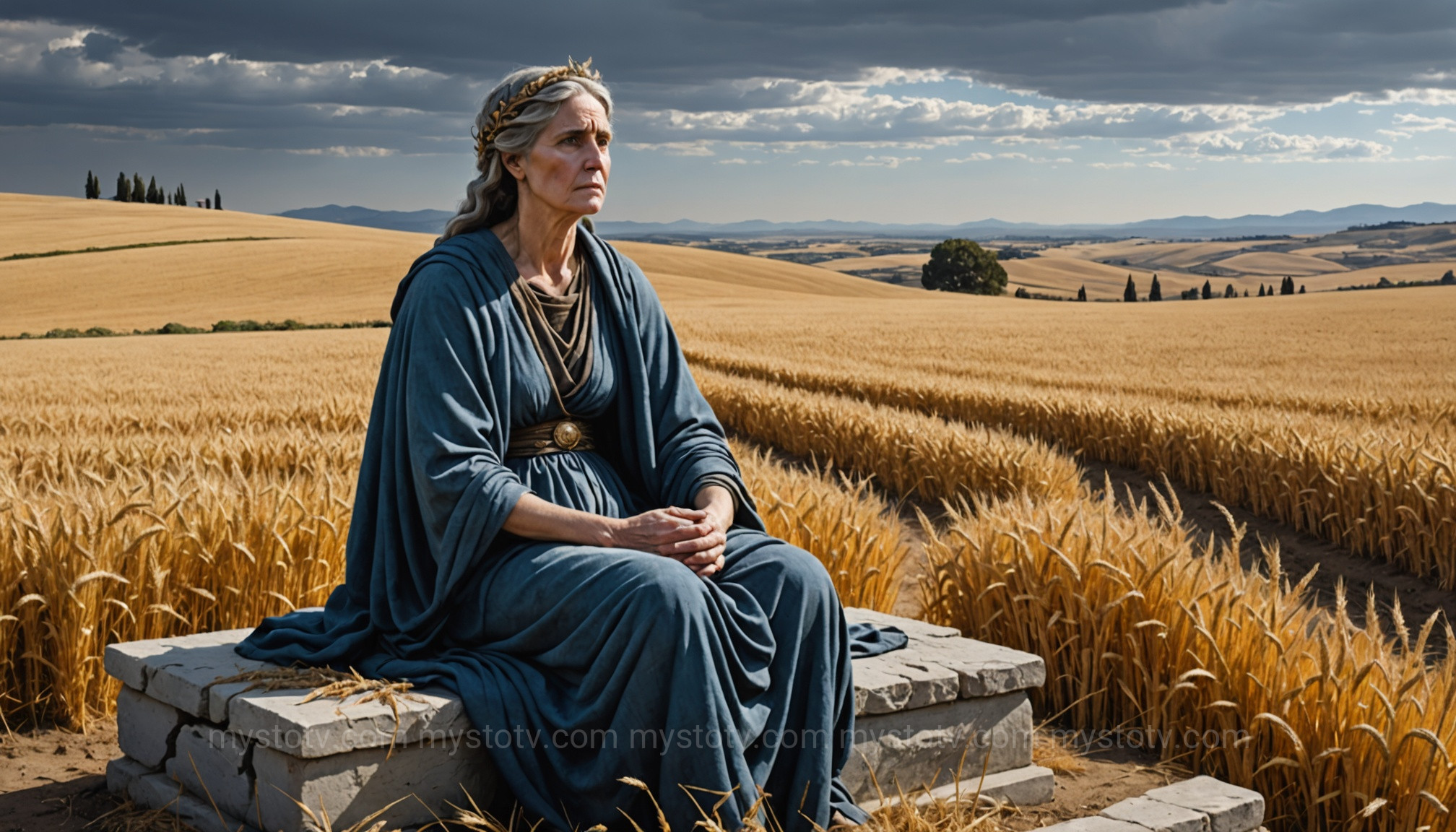Contents
- 1 The Abduction: Unpacking the Core of the Story of Persephone and Hades
- 2 A Mother's Grief: How Demeter's Sorrow Shaped the Story of Persephone and Hades
- 3 The Underworld's Queen: Persephone's Transformation in the Story of Persephone and Hades
- 4 The Compromise and the Creation of Seasons: The Enduring Legacy of the Story of Persephone and Hades
- 5 Beyond the Seasons: Modern Interpretations of the Story of Persephone and Hades
- 6 Answering Your Questions About the Story of Persephone and Hades
- 7 References
The Abduction: Unpacking the Core of the Story of Persephone and Hades

The myth begins not with darkness, but with brilliant light. At its center is a young goddess whose initial identity is one of pure, untroubled innocence. This foundational event, the abduction, serves as the violent catalyst for every transformation that follows, setting in motion a divine drama that will forever alter both the celestial and mortal realms.
Who was Persephone Before the Underworld?
Before she was the formidable Queen of the Underworld, she was Kore (meaning "the maiden"), the cherished daughter of Demeter, the goddess of grain and agriculture, and Zeus, the king of the gods. Kore was the personification of spring. Her days were spent in sunlit meadows with the Oceanids, weaving garlands and gathering flowers, blissfully unaware of the world's darker facets. She represented new growth, the budding of flowers, and the carefree joy of youth. Her existence was intrinsically tied to the earth's vitality, a direct extension of her mother's domain over the harvest and fertility.
Hades' Gaze and the Fateful Chariot
While Kore embodied life, Hades, ruler of the Underworld, presided over the dead. He was a formidable and lonely deity, brother to Zeus and Poseidon, who had drawn the short straw and been assigned the grim, sunless realm. From his subterranean kingdom, he watched the world of the living and became captivated by Kore's beauty. With the tacit approval of her father, Zeus—a detail often highlighting the patriarchal structures of the time—Hades planned to make her his queen. One day, as Kore reached for a particularly stunning narcissus flower (planted by Gaia at Zeus's request to lure her), the earth split open. Hades thundered out in his golden chariot pulled by immortal black horses, seized the terrified maiden, and descended back into the depths of the earth before her cries could be fully heard. This event marks the true beginning of the story of Persephone and Hades.
Analysis: The abduction is more than a simple kidnapping; it's a symbolic shattering of innocence. It represents a violent transition from girlhood to womanhood, a theme common in many coming-of-age stories. Zeus's complicity is crucial, reflecting ancient Greek marriage customs (arrhae), where fathers often arranged their daughters' marriages without their consent. The abduction forces a confrontation between life (Kore/Demeter) and death (Hades), setting the stage for a new cosmic order.
A Mother's Grief: How Demeter's Sorrow Shaped the Story of Persephone and Hades

The echo of Persephone's cry did not go entirely unheard. Her mother, Demeter, felt a pang of loss and began a desperate search. This maternal anguish becomes the driving force of the narrative, demonstrating that the love of a mother could be powerful enough to challenge the king of the gods and bring the world to its knees.
The Desperate Search
Hearing only a faint cry, Demeter was frantic. Tearing the veil from her head and donning dark robes of mourning, she took up two torches and began to wander the earth, forgoing ambrosia and nectar, refusing to bathe or anoint herself. For nine days and nights, she searched without rest, asking every god and mortal she met if they had seen her daughter. No one would tell her the truth, either out of fear of Hades or of Zeus himself. Finally, on the tenth day, she encountered Hecate, the goddess of magic and crossroads, who had also heard the cries. Together, they went to Helios, the all-seeing sun god, who revealed the entire truth: that Hades had taken her with Zeus's permission.
The World Withers
Consumed by grief and rage at this betrayal, Demeter abandoned her divine duties on Mount Olympus. Disguised as an old woman named Doso, she wandered among mortals, eventually arriving at the city of Eleusis. In her sorrow, she withdrew her life-giving power from the earth. The soil became barren, seeds refused to sprout, and the plows of men cut through infertile ground. A terrible famine gripped the world, and the cries of starving mortals reached the heavens. The gods were deprived of their sacrifices and tribute. Zeus, realizing the catastrophe unfolding, understood he had to act. The profound impact of Demeter's grief is a central element of the story of Persephone and Hades, directly linking a god's emotion to a natural phenomenon.
Analysis: Demeter's reaction transforms her from a nurturing earth mother into a fearsome power. Her grief is not passive; it is an active, destructive force. This section of the myth establishes a critical concept: the interconnectedness of divine emotion and the natural world. It argues that the cycles of nature are not impersonal but are driven by the passions, loves, and sorrows of the gods. This personification made the changing seasons an intimate and relatable drama for the ancient Greeks.
The Underworld's Queen: Persephone's Transformation in the Story of Persephone and Hades

While the world above suffered, a profound transformation was occurring in the world below. The narrative of Persephone is not one of perpetual victimhood. Instead, it is a story of adaptation, growth, and the assumption of power. She enters the Underworld as a captive maiden but emerges as its undisputed Queen.
From Maiden to Monarch
The myth doesn't detail Persephone's initial time in the Underworld extensively, but later interpretations and classical art depict her as a solemn but powerful figure. She was not a prisoner locked in a cell; she was the consort of a king. She learned the laws and landscape of her new domain, a realm of shadow, memory, and finality. Over time, she assumed her role with a grace and gravitas that earned her the respect of its inhabitants—the shades of the dead—and the title "The Dread Queen Persephone." She became the necessary balance to Hades: while he was the ruler of the dead, she was the link to the world of the living, a symbol that life and death are two sides of the same coin.
The Pomegranate Seeds: A Symbol of Binding and Choice
After the pleas of the gods and the suffering of mortals, Zeus finally relented and sent the messenger god, Hermes, to the Underworld to retrieve Persephone. Hades agreed to let her go, but before she left, he offered her a final parting gift: a pomegranate. Knowing that anyone who consumed food in the Underworld was bound to it, he tempted her. The Homeric Hymn to Demeter says he "stealthily gave her sweet pomegranate seed to eat." Persephone, whether through trickery, hunger, or a nascent acceptance of her new life, consumed a few seeds—the number varies in different accounts, from a single seed to six. This act sealed her fate. She could return to her mother, but she could never completely leave the Underworld. This pivotal moment in the story of Persephone and Hades is rich with symbolic meaning. For more on the rites connected to this myth, you can learn about the Eleusinian Mysteries.
Analysis: The act of eating the pomegranate seeds is the myth's most debated point. Was it an act of coercion or of agency? Modern interpretations often see it as Persephone's first true choice—a conscious decision to embrace her dual nature and claim her power in both realms. The pomegranate, with its blood-red juice and multitude of seeds, is a potent symbol of life, death, and fertility. By consuming it, Persephone internalizes her connection to the Underworld, transforming her bond with Hades from one of captivity to one of cyclical, unbreakable connection.
The Compromise and the Creation of Seasons: The Enduring Legacy of the Story of Persephone and Hades

The consumption of the pomegranate seeds necessitated a divine compromise. Persephone could not be fully restored to her mother, nor could she be kept forever from the sunlit world. The resolution reached on Mount Olympus would become the foundational explanation for the earth's natural rhythms and the most famous legacy of this myth.
The Deal Struck on Olympus
When Persephone returned and revealed she had eaten the food of the dead, Demeter's joy turned back to despair. However, a solution was brokered, likely by Zeus's mother Rhea, to appease all parties. It was decreed that for the portion of the year corresponding to the seeds she had eaten (typically one-third or one-half of the year), Persephone must return to the Underworld to rule by Hades's side as his queen. For the remaining part of the year, she could return to the surface world to live with her mother, Demeter. This compromise pacified Demeter and saved humanity from starvation.
Spring's Return and Winter's Reign
This divine arrangement gave birth to the seasons. When Persephone ascends from the Underworld each year, her joyful mother, Demeter, allows the earth to bloom and become fruitful. This is the time of spring and summer, a period of life, growth, and abundance. But when the time comes for Persephone to descend once more, Demeter grieves anew. She withdraws her gifts from the world, and the earth grows cold and barren. This is the time of autumn and winter, a period of dormancy and reflection. The annual journey of Persephone became the heartbeat of the world, a celestial clock marking the endless cycle of death and rebirth that is fundamental to the story of Persephone and Hades.
Analysis: This explanation for the seasons is emotionally resonant and poetically brilliant. It weaves a natural phenomenon into a personal story of love, loss, and reunion. Rather than a cold, scientific process, the changing of the seasons becomes an empathetic event. We experience winter's chill as Demeter's sorrow and celebrate spring's warmth as a mother's joy. The myth provides a "why" for the "what," satisfying a deep human need for meaning and narrative in the world around us.
Beyond the Seasons: Modern Interpretations of the Story of Persephone and Hades

The power of the story of Persephone and Hades extends far beyond its ancient etiological function. Today, the myth is explored through psychological, feminist, and artistic lenses, revealing its timeless relevance to the human condition and our understanding of complex relationships.
A Tale of Duality and Growth
From a psychological perspective, Persephone's journey is the archetypal story of the journey into the "shadow self." The Underworld represents the subconscious, the parts of ourselves we fear or do not know. By being forced into this realm, Persephone confronts darkness, death, and her own hidden potential. Her return is not to her former state of innocence but to a new state of wholeness. She integrates her two selves—the Maiden of Spring and the Queen of the Dead—becoming a symbol of psychological maturity and the ability to navigate both the light and dark aspects of life.
Feminist Readings and Reclaiming the Narrative
Modern feminist interpretations often re-examine Persephone's agency. While the original myth depicts her as a victim of abduction, many retellings explore the possibility of a more complex relationship with Hades. They question the narrative of a weeping, passive captive and instead portray a woman who finds power, purpose, and perhaps even love in a realm that is her own. These readings focus on her growth from an object of divine transaction into a sovereign ruler in her own right, challenging traditional patriarchal interpretations and reclaiming the story of Persephone and Hades as a tale of female empowerment.
Enduring Influence in Pop Culture
The myth's raw emotional power has made it a favorite source of inspiration for contemporary creators. From the wildly popular webcomic and graphic novel series Lore Olympus by Rachel Smythe, which reimagines the story as a modern romance, to novels like A Touch of Darkness by Scarlett St. Clair and countless poems and songs, the tale continues to be reinvented. Each new interpretation proves that the core themes—love, loss, consent, power dynamics, and the cycle of transformation—are as relevant today as they were thousands of years ago.
Analysis: The persistence of this myth in modern culture demonstrates its "stickiness." The characters are not flat, one-dimensional figures; they are complex beings whose motivations can be interpreted in countless ways. The story's ambiguity—especially regarding Persephone's feelings and the nature of her relationship with Hades—provides fertile ground for artists and writers to explore timeless questions about identity, relationships, and power.
Answering Your Questions About the Story of Persephone and Hades
The myth of Persephone and Hades is rich and complex, often leaving us with lingering questions. Here are answers to some of the most common queries.
Did Persephone willingly eat the pomegranate seeds?
The primary ancient source, the Homeric Hymn to Demeter, is ambiguous. It states Hades "gave her... to eat, stealthily," which implies a degree of trickery. However, it doesn't explicitly state she was forced. This ambiguity allows for multiple interpretations. Some scholars argue the act was a trap she fell into. Others, particularly in modern retellings, portray it as a conscious choice—an act of agency where Persephone claims her place in the Underworld and ensures her own return, unwilling to be a mere pawn in the games of the Olympian gods.
Did Persephone and Hades love each other?
The ancient texts focus more on the abduction and the creation of seasons than on the romance. In most classical accounts, theirs is one of the few monogamous relationships among the major Greek gods. There are no stories of Hades taking other lovers after Persephone becomes his queen. Later traditions and modern interpretations have heavily leaned into the romantic aspect, developing the narrative into a love story. They often depict Hades as a lonely, misunderstood figure who deeply respects and loves his queen, and Persephone as someone who comes to love the god who sees her not just as the maiden of spring, but as a powerful ruler.
What are the Eleusinian Mysteries and how do they relate to this myth?
The Eleusinian Mysteries were secret initiation rites held annually in ancient Greece at Eleusis, where Demeter rested during her search. They were among the most important and sacred religious rituals of the ancient world. The rites were based directly on the story of Persephone and Hades. Initiates would re-enact the myth—Demeter's sorrow, the search, and Persephone's return. The central promise of the Mysteries was a form of spiritual enlightenment and the hope of a blessed afterlife, mirroring Persephone's own journey through death (the Underworld) and rebirth (her return to the living world). Participation was believed to grant a happier existence after death.
The complete story of Persephone and Hades is a masterpiece of mythological storytelling. It is a tale that operates on multiple levels: as a beautiful and poignant explanation for the changing of the seasons, as a deep psychological exploration of trauma and growth, and as a complex drama about family, power, and love. It reminds us that there is life in death and light in darkness, and that the cycles of sorrow and joy are what shape our world. Far from being a simple relic of the past, this ancient myth continues to resonate, teaching us that every winter, however long, eventually gives way to the promise of spring.
References
- Homeric Hymn 2 to Demeter. (n.d.). In Theoi Project. Retrieved November 2023. https://www.theoi.com/Text/HomericHymns2.html
- Atsma, Aaron J. (2000-2017). PERSEPHONE. In Theoi Greek Mythology. Retrieved November 2023. https://www.theoi.com/Khthonios/Persephone.html
- Cartwright, Mark. (2018, April 19). Eleusinian Mysteries. In World History Encyclopedia. https://www.worldhistory.org/Eleusinian_Mysteries/